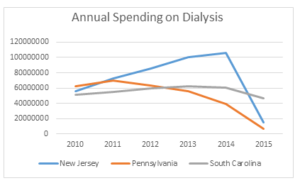Response to Kaiser Health News Ambulance Billing Article
Below is the American Ambulance Association’s Response to a recent Kaiser Health News article on ambulance billing. It was reprinted in several metropolitan areas on November 20, 2017.
To the Editor:
I write today in response to Melissa Bailey’s November 20 piece about ambulance balance (“surprise”) billing. While we disagree with the characterization of ambulance services in the article, we welcome the ongoing public dialogue about how unsustainable reimbursement for emergency medical services results in cost-shifting to patients.
Missing from the article is a true understanding of the sky-high cost of readiness for emergency medical services. Ambulance service providers offer their communities 24/7/365 on-demand mobile healthcare. Skilled staff and ambulances—high-tech emergency rooms on wheels—are ready to respond to a 9-1-1 call at a moment’s notice to help patients with issues ranging from stroke to heart attack to trauma to childbirth. EMS is also on the very front lines of the surge in opioid overdoses, providing naloxone (Narcan) to hundreds of patients each day. Keeping supplies, medications, equipment, and personnel at-the-ready requires a significant ongoing investment, regardless of whether or not an ambulance is out responding to a call. Cost comparisons between EMS and the rideshare app Uber may make for catchy sound bites, but they are misleading and misguided.
The piece states that our nation’s 14,000 ambulance service providers received 1,200 Better Business Bureau complaints spread over three years. While certainly not optimal, this is a tiny, unrepresentative fraction of the tens of millions of responses ambulance service providers conduct annually. In fact, BBB 2016 statistics show that ambulance services receive far fewer complaints than hospitals, physicians, dentists, and many other trusted healthcare providers.
The article also offhandedly mentions that balance billing occurs when private insurers and ambulance service providers are unable to agree about fair reimbursement rates. This glosses over the dark reality that it would be hard to categorize the process that occurs between the insurer and ambulance services as a “negotiation.” Instead, insurers often present an all-or-nothing proposition to force ambulance service providers to accept contracts at unsustainably low reimbursement rates. Unlike the multi-billion dollar insurance behemoths, most ambulance services are small and operate on razor-thin margins. In fact, 73% of ambulance services provide fewer than 1,000 Medicare transports per year—just three per day. Ambulance services do not turn down insurance network contracts out of greed, but instead out of necessity. Facing reimbursement rates below the cost of the services they provide, they must decline these agreements in order to keep their doors open and continue to provide healthcare to their communities. Unfortunately, this sometimes creates a situation where out-of-network ambulance costs are shouldered by patients via balance billing, instead of insurers.
In addition to challenges receiving fair compensation from private insurance, EMS is stretched thin by ultra-low Medicare and Medicaid reimbursement rates. In fact, in 2007 and 2012 GAO studies showed that without temporary, Congress-authorized percentage increases in EMS payments, ambulance services would receive reimbursement from government payors below the cost of operations. These are often the very same unsustainable rates that private insurers are attempting to strong-arm EMS providers into accepting for network contracts.
Finally, when someone calls 9-1-1 in need of emergency medical care, it is key to recall that, unlike in other industries, an ambulance responds regardless of the patient’s ability to pay. In many cases, the patient does not have insurance and is financially unable to reimburse the ambulance service provider. Therefore, EMS provides a significant amount of uncompensated care, the cost of which must be spread across all payors in order for them to continue their life-saving operations.
Ambulance services provide an essential, on-demand healthcare benefit to their communities. Unfortunately our current healthcare payment structure means that much of this care is not compensated equitably, resulting in the necessity of balance billing patients. While there are no quick fixes for this issue, we encourage consumers to educate themselves about their own insurance coverage. We also ask for your support of legislation that provides sustainable reimbursement for ambulance providers, including the bipartisan US Senate Bill 967. Together, we can ensure the future of mobile healthcare in our great nation.
Mark Postma
President
American Ambulance Association
“Representing EMS In America”


















